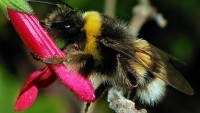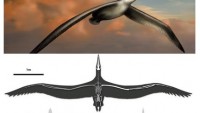Wind Turbines Killing Both Local and Migratory Birds in Large Numbers
| Arthur Dominic Villasanta | | Oct 13, 2016 02:34 AM EDT |
Dead eagle at a wind farm.
Wind turbines, while providing clean energy, remain one of the leading killers of birds worldwide and a new study has discovered up to a fourth of the birds killed in collisions with the blades of turbine propellers are out-of-town or migratory species.
Globally, wind turbines, many of them grouped in wind farms with hundreds of machines, have been responsible for the deaths of anywhere from 140,000 to 328,000 birds and 500,000 to 1.6 million bats.
Like Us on Facebook
One study, however, claims wind turbines will kill 1.4 million birds yearly by 2030.
This huge number of deaths raises questions about the effects of wind turbines on the population sustainability of flying creatures.
Studies show the Altamont Pass Wind Resource Area (APWRA) in Livermore, California has the worst bird-kill problem in the world among wind farms. That's because of the turbines are located along a major migration route for birds of prey in North America that attracts among the highest concentration of golden eagles in the world.
Another reason for the wind farm's grisly reputation is the massive number of turbines at Altamont: almost 5,000 small and large turbines.
One study claims the Altamont wind farm has killed close to 3,000 golden eagles or goldies since it opened in 1981 until 2013.
Scientists previously believed most of the birds killed at Altamont live nearby. New research, however, shows evidence that birds from up to hundreds of miles away make up a significant portion of the raptors killed at these wind energy fields.
Using DNA from tissue and stable isotopes from the feathers of golden eagle carcasses, researchers from Purdue University and the U.S. Geological Survey found that golden eagles killed at Altamont can come from hundreds of miles away.
Golden eagles are a species of conservation concern, so understanding population-level differences and how individuals interact with turbines is key to meeting a U.S. Fish and Wildlife Service target of no net loss to their populations.
"Eagles tend to use that habitat around the turbines. It's windy there, so they can save energy and soar, and their preferred prey, California ground squirrels, is abundant there," said J. Andrew DeWoody, a Purdue professor of genetics in the Department of Forestry and Natural Resources.
"As they soar, these eagles are often looking straight down, and they fail to see the rapidly moving turbine blades. They get hit by the blades, and carcasses are found on the ground under the turbines."
Collaborator David Nelson, a stable isotope ecologist with the University of Maryland Center for Environmental Science, tested the birds' feathers for stable hydrogen isotopes, which can be used to determine where the birds likely grew their feathers.
The research team determined that about 75 percent of the 62 birds were from the local population. The remaining 25 percent likely migrated into the area before they were killed.
A genetic analysis revealed that golden eagles from the western U.S. have gene pools similar to those killed at the APWRA, which reflects the capacity of these birds to disperse widely.
The study was published in Conservation Biology on Sept. 28.
TagsWind Turbines, Altamont Pass Wind Resource Area, Golden Eagles, bats, california, U.S. Fish and Wildlife Service, U.S. Geological Survey
©2015 Chinatopix All rights reserved. Do not reproduce without permission
EDITOR'S PICKS
-

Did the Trump administration just announce plans for a trade war with ‘hostile’ China and Russia?
-

US Senate passes Taiwan travel bill slammed by China
-

As Yan Sihong’s family grieves, here are other Chinese students who went missing abroad. Some have never been found
-

Beijing blasts Western critics who ‘smear China’ with the term sharp power
-

China Envoy Seeks to Defuse Tensions With U.S. as a Trade War Brews
-

Singapore's Deputy PM Provides Bitcoin Vote of Confidence Amid China's Blanket Bans
-

China warns investors over risks in overseas virtual currency trading
-

Chinese government most trustworthy: survey
-

Kashima Antlers On Course For Back-To-Back Titles
MOST POPULAR
LATEST NEWS
Zhou Yongkang: China's Former Security Chief Sentenced to Life in Prison

China's former Chief of the Ministry of Public Security, Zhou Yongkang, has been given a life sentence after he was found guilty of abusing his office, bribery and deliberately ... Full Article
TRENDING STORY

China Pork Prices Expected to Stabilize As The Supplies Recover

Elephone P9000 Smartphone is now on Sale on Amazon India

There's a Big Chance Cliffhangers Won't Still Be Resolved When Grey's Anatomy Season 13 Returns

Supreme Court Ruled on Samsung vs Apple Dispute for Patent Infringement

Microsoft Surface Pro 5 Rumors and Release Date: What is the Latest?














